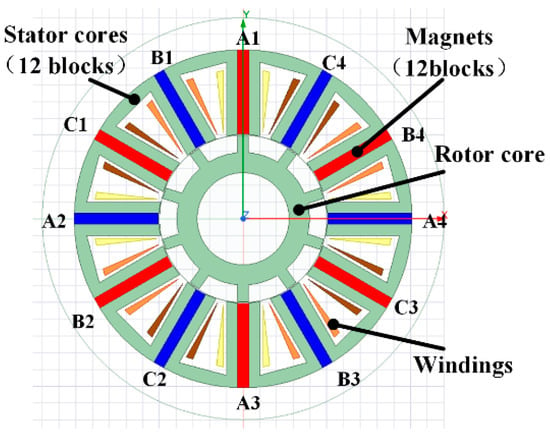In the area of transmission, direct-driven motors are commonly used due to their characteristics of high precision and quicker dynamic response [1,2]. Unlike the drive structure of the leading screw and reducer, which can disperse stresses by the mechanical structure, the load of the direct drive motor is completely supported by the electromagnetic torque of the motor. So, the windings require a lot of current to generate torque, which also makes a lot of heat. Therefore, the direct drive motor usually uses a water jacket, slot cooling method, etc., to cool the motor stator [3]. Due to motor rotor structural constraints, its heat dissipation performance is usually inferior to that of the stator. The heat of the rotor can usually only be cooled by the air inside the motor, and the cooling efficiency is poor. Most direct drive motors have permanent magnets installed in the rotor, which increases the risk of demagnetization of permanent magnets at high temperatures. Figure 1 shows the FSPM motor configuration. Its permanent magnets are installed in the stator [4,5,6]. That makes the permanent magnet easier to cool during a motor-heavy load.
However, the FSPM motor has some characteristics that limit its application. The FSPM motor has doubly salient poles, which obviously lead to torque ripple [7,8]. Such characteristics are apparently unfavorable for the requirements of high precision and high dynamic response. It is precisely because of the characteristics of the FSPM motor that many researchers have contributed a lot of work to analyzing the torque ripple of the FSPM motor.
Some researchers focus on the current excitation. In [9], various sources of salient rotors with modular rotor FSPM are compared, and their average torque and cogging torque are analyzed. Some researchers proposed new structures to improve the torque ripple of FSPM. In [10], the authors propose that the cogging torque of flux-switching transverse flux permanent magnet machine is significantly influenced by the ratios of stator and rotor core circumferential widths to pole pitch. In [8], the authors study the torque ripple of FSPM and point out that the torque harmonics are generated by the interaction between the radial and tangential air gap harmonics. They proposed a V-shape permanent magnet that improves the air gap harmonics effectively. In [11], an H-type FSPM linear generator was proposed. The Taguchi optimization approach was used to reduce the force ripple and increase the average thrust force and efficiency. In [12], the authors proposed a new design approach that improves the E-shaped FSPM linear motor to reduce the force ripple. In [13], the authors proposed a novel consequent pole E-core stator FSPM machine that reduces stator flux linkage and torque ripples. In [14], the skewed slot of the rotor is designed to optimize the EMF harmonic character and cogging torque. In [15], a magnetic flux barrier is designed in the rotor to improve the performance of FSPM including the torque ripple. In addition to structural design methods, some researchers also study the control algorithm to improve the torque performance [16]. Some researchers focus on the basic size change in the performance of motors. In [17], the rotor pole width was studied to minimize back-EMF harmonics. In [18], the stator pole shape was mainly studied to optimize the flux linkage, back EMF, and cogging torque. In [19], different coil group sets and shifting rotor teeth were studied to optimize the back-EMF waveform. Ref. [20] proposed two types of rotor configurations and optimized the cogging torque with multiple factors. Ref. [21] studied the dimensions of permanent magnet and rotor teeth to optimize the average torque and cogging torque.
In general, the methods to suppress the output torque ripple of FSPM motors mainly focus on the optimization of new structures. Inspired by these studies, the main factors to affect the torque ripple are salient pole dimensions at the air gap. These shape dimensions are related to several parameters. Therefore, this paper focuses on the rotor and stator poles combined optimization to reduce the torque ripple and promote the average torque. In considering more detailed features, the rotor shape is refined and its effect on the torque characteristics of the motor is studied to improve the motor further.
Source link
Chen Liu www.mdpi.com


